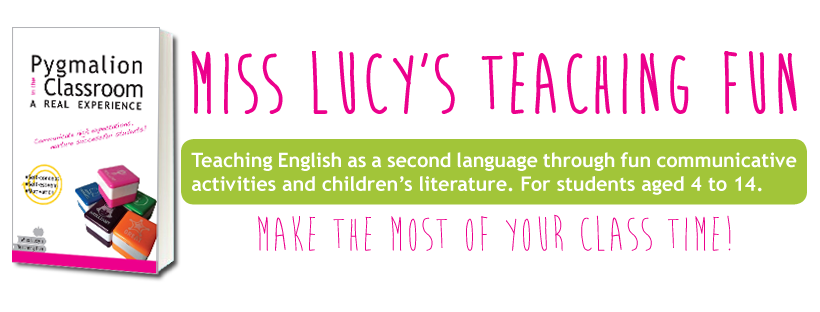Hola a todos!
Un pequeño post sobre lo que estamos haciendo, yo y mis brillantes alumnos de 1º y 2º de infantil, en un colegio de Madrid, durante este mes de junio.
Hemos hecho muchas preguntas: What's your name? What's your brother/sister/ mother/father/granny/grandfather's name? What day is it today? What's the weather like? Where do you live? How old are you?
Seguimos con las canciones: hasta ahora hemos leído, cantado, bailado y jugado con The Wheels on the Bus, We're Going on a Bear Hunt y Five Little Monkeys.
Después hemos visto varios animales de la selva: bear, crocodile, lion, bird, giraffe, zebra, elephant, hippo.
Hemos jugado a Good Afternoon Mr Jones, para aprender esta palabra' afternoon' súper complicada :o)
También hemos jugado a What's the time Mr Wolf? para repasar números y animales ( se dan ciertos números de pasos según el animal elegido) y I can see, I can see…(a red bird) …across the sea, un juego donde se necesitan a captain/pirate y a shark más flashcards (o dibujos), que resulta muy útil para empezar a poner adjetivos delante de los sustantivos.
También hemos explorado las emociones haciendo muecas y por fin…pintado!
Hemos pintado palabras que empiezan por J (jump, jellyfish, jet, juice), K (kite, king, kitten), L (leaf, lemon, lorry, lion, Lollipop) M (mitten, milk, moon, monkey) y P (penguin, pie, pig, pencil). Las hemos revisado cada día con juegos y adivinanzas.
En fin, mucho trabajo! Y mucha diversión!
..............................................
Hi everyone!
This is a little post about my June Intensive Course. I'll tell you what my young students and I have been up to over these past 2 weeks of English classes.
First we've been asking and answering several questions: What's your name? What's your brother/sister/ mother/father/granny/grandfather's name? What day is it today? What's the weather like? Where do you live? How old are you?
Then we've been singing along to these songs:
We've been doing many activities to learn them such as reading their books, playing musical chair, musical statue and listening to them during painting time.
We've also seen the words for many wild animals, such as bear, crocodile, lion, bird, giraffe, zebra, elephant, hippo.
We've played 'Good Afternoon Mr Jones' to learn this word 'afternoon' that seems a little tricky to pronounce.
We've played What's the Time Mr Wolf?' to review the numbers and animals, (every turn we pretend to be an animal, and we walk and produce strange sounds).
We've played I Can See, I Can See… ( a red bird) …Across the Sea, a game that needs a captain/pirate and a shark, to learn that in English adjectives go before nouns.
We've played Cops and Robbers and Bump the Color, also.
We've explored our emotions by pulling faces and finally… We colored!!!
We painted words that start with J (jump, jellyfish, jet, juice), K (kite, king, kitten), L (leaf, lemon, lorry, lion, Lollipop) M (mitten, milk, moon, monkey) and P (penguin, pie, pig, pencil).
We've been reviewing them every day through quiz games.
Actually, a lot of work, but also a lot of fun!


+10:56.jpg)







